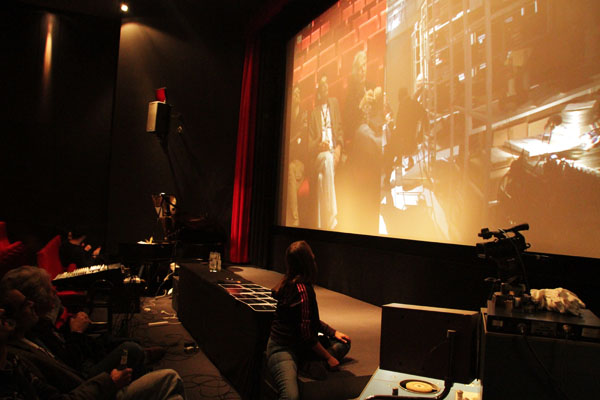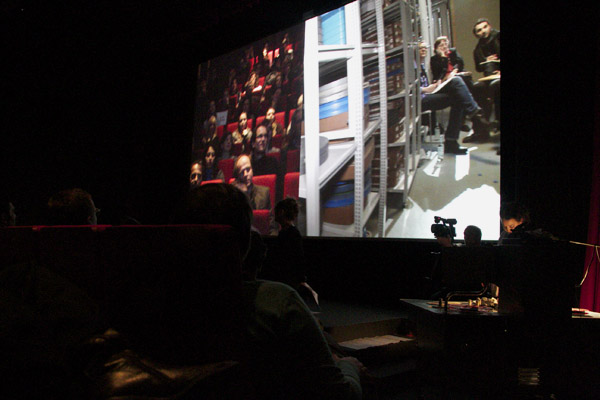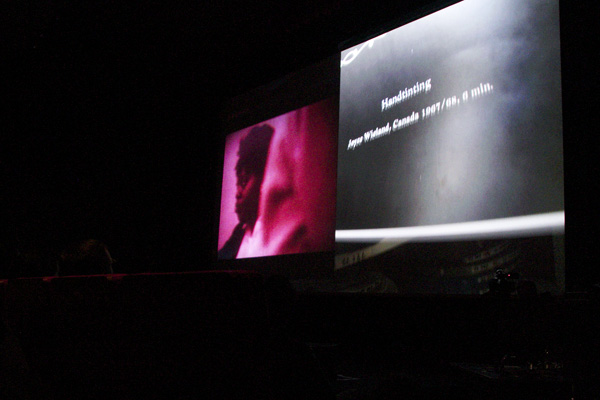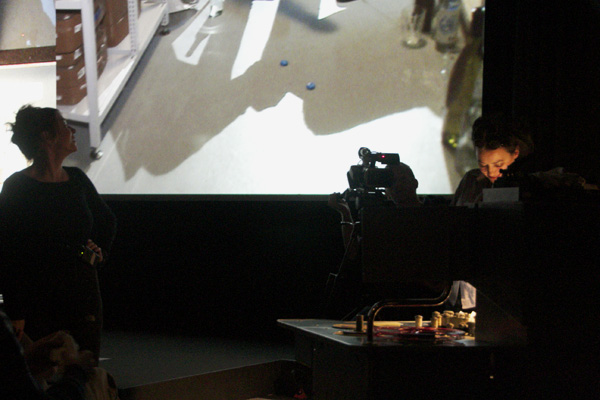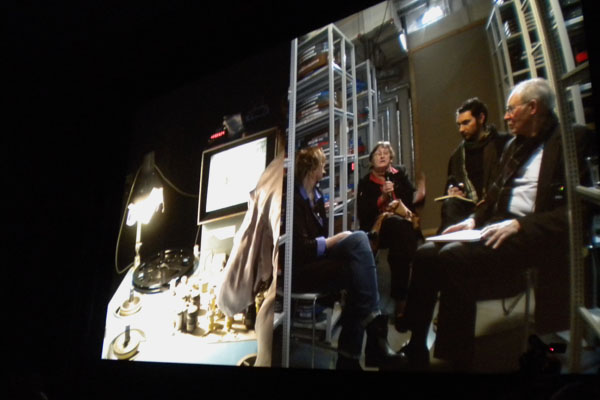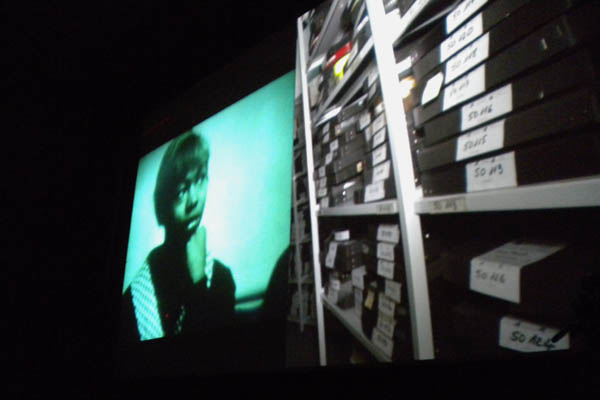The "Möglichkeitsraum" (The Blast of the Possible) for the Living Archive project
picks up on the format used for the BDF film/performance. Once again, a film editing table will be placed on the stage and will be filmed during the performance, alongside the film and video projection. Thus the cinema will be transformed into a post-editing or screening room. Therefore, the room in which the construction usually takes place before the moment of presentation will be turned back into a production space in the representation space. The archaic and theatrical function performed by the cinema stage (performance) will be combined with the zone of association (control desk, montage) and screening. The relationship between the clash of different timeframes (cinema and performance), which in the history of cinema has been celebrated as a progressive moment towards advanced consciousness (expanded cinema), but has also cropped up as a regressive element of porn cinema, is performative.
In the Living Archive project, the cinema will give way to the realm of possibilities for performative archival viewing acts. The film (its current interpretation, its possible past and its power for the future) in the archive (its arrival, stay and disappearance) will become a live performance through the act of being seen. The format will be developed prior to the performance.
Developing the format
In order to further develop the cinema stage that has already been expanded by a 16/35 mm editing table and double video projections, we are mapping all "in and output relations" between the Arsenal cinema and the editing table. The idea is to explore the stage with its trapdoors (stage effects, special effects) and the technical possibilities for the montage/performance because in the realm of possibilities the stage is understood as a collective mental space that constitutes the group subject but only wants to be understood in the cinema itself.
An audio or sound recording in the cinema will allude to the archive: Audios recorded in post-screening Q&As or panels play a very important role for us and the Arsenal's sonic archive could become the basis for the development/composition of new audio tracks, which would refer to the sound/image relationship in the archive on the one hand, and on the other to the Arsenal's design (for example, the recording studio behind the screen in Cinema 1 that will also be a production space for our project).
Film did not only emerge from theater and it also serves other dramas than those of the theater. When Arsenal was designed, a cinema stage with entrances and exits, a screen and a stage were also allowed for next to the archive. The building's screening room, the goods elevator behind the projection room, the recording studio behind the screen in Cinema 1, etc, are all being examined for possible associations in the cinema (e.g. windows of light and loud doors, electronic access to sound and image in the cinema, cables, microphones etc.). The work on the editing table will also deal with the opening and closing scenes of the film, searching through a film during playback and this will be documented on video and can then be integrated into the performance: A live making-of a searching-for.
Another way to bring together the cinema and archive's history and architecture productively is to find filmic equivalents for all the above-mentioned openings, corridors, trapdoors, lifts etc. (in a cinematic narrative, in a visual composition, in a dramatic resolution, in a dialogue between two protagonists), and to "project" them – whether symbolically or for real – onto the building. The work on the "access and departure" to and from the Arsenal archive, as well as on the "transmission" (of statements, i.e. films) will describe the "life of the film" beyond the borders of sound and image, beyond the planning of the image production at the level of the maker’s fabrication or experiment. The distribution of the film (festival, seminar etc) describes the cinema as a sensor of events and time with its windows of experience and pro/regressive time-spaces. After the Arsenal cinema has been mapped, the "realm of possibilities" will be thought of as a film/performance stage for screening and projecting specific films.
Post-feminism/technology/cinema
Continuing our work in the BDF with Stefanie via Arsenal (feminism/film/festival), I/we would like to continue watching films that deal with technical production or the history of the media, and body production. If cinema is considered a realm of possibilities for highlighting new constellations of subject, then to show a film (in a festival or at a political event) becomes a ritual procedure, during which different body constellations (positions) and mental worlds (cosmologies) are projected upon us. Mediality in a cinema can be understood as a schizophrenic/oedipal trick of modern bodies, like in 1970s film theory, in which the production/consumption is dividing into the opposing poles of audience/production. However, this polarization has to be problematized. (Is there a false life in film and in the cinema? Etc.) One can understand cinema as a production space, in which the relationships function in a "schizogamic" manner (i.e. in the way a body produces other bodies by when certain parts of it are detached). The cosmology of "schizogamy" is thus an enabler of different, subjective constellations whose position claims the invention of post-feminism (2007, Elisabeth von Samsonow, Anti-Electra).
The cinema as a production space construes machine-subjectivities with means that experimental film and media art have frequently deployed. What is the moment when subjectivity in a cinema that is linked to an archive is produced? How is the moment that new subject constellations emerge articulated in the time-dramaturgy of a cinema whose history is shaped by the archive?
By associating the woman/machine potentials feminist film highlighted the consistency level of technical and social development that then became central to philosophy (the becoming-woman of production, desiring machines etc.) What does the schizogamic relation (production of bodies from the body as a position of knowledge) in its non-heteronormative history of production? To link the statement to the fabric of statements is to claim an autonomous production zone of statement. (Hereby, performativity is at certain moments a realized form of technological history.) The emergence or invention of new subject positions is considerably more autonomous than one might have imagined. The expression of these inventions is transversal, alive, animistic and magical, which means it is both a technical invention and the invention of a potential sociality at once. Thus expressivity can thus not only be found in the film but also in the combination of film/audience or film/production/archive, and the cinema consequently becomes a production space, or even a post-production space. The subject positions that agitate within this space are ritual, mechanical, virtual and performative. They accompany the cinema with a not yet realized story of collective articulation, which breaks with the theater but makes the break, which the theater claims as a cosmic construction plane for itself, a constituent part of the psyche's narrative. Therefore, it is the cinema which introduces the notion of a collective emotional construction plane into the history of psychoanalysis. With such places, a cosmology remains within reach in the city (Berlin) and thanks to the Arsenal cinema it is open and can be experimented with.
Berlin, 18.11.2011
